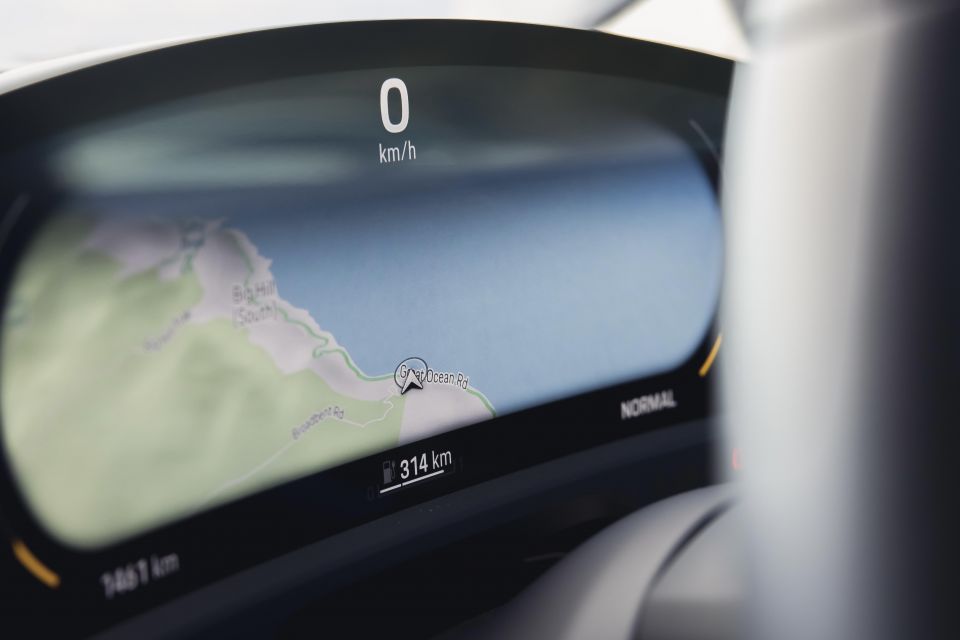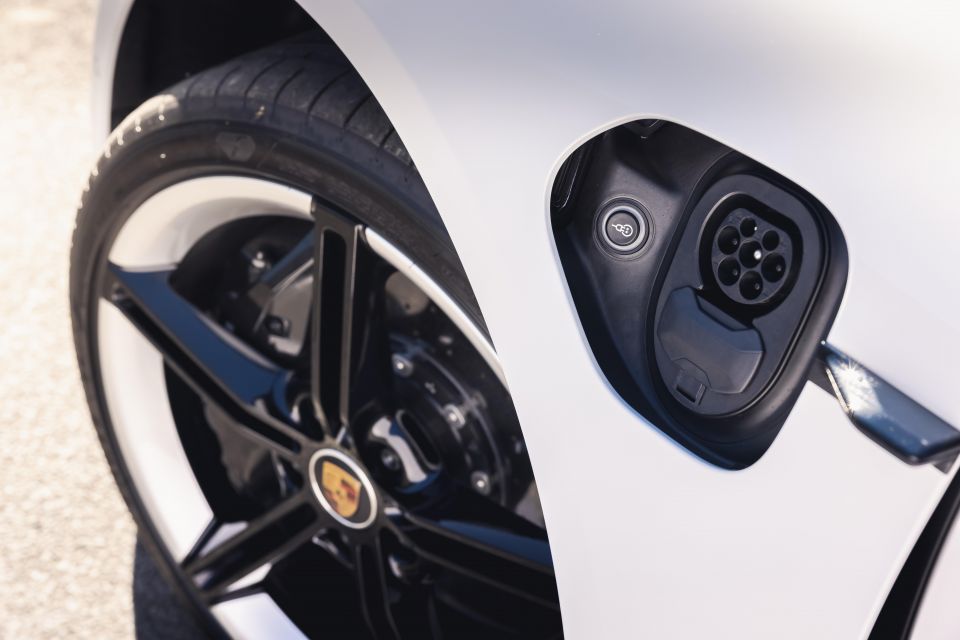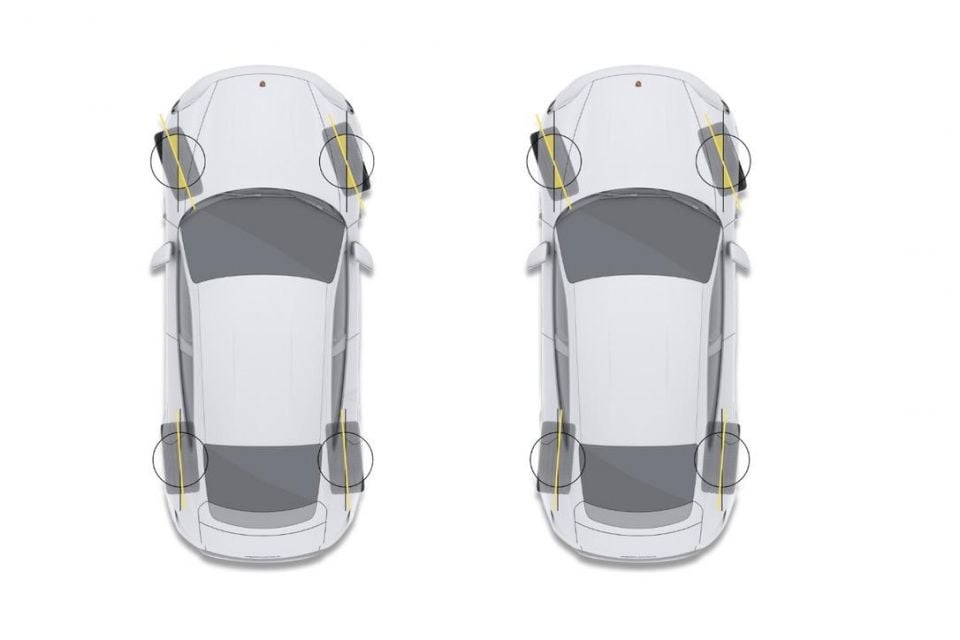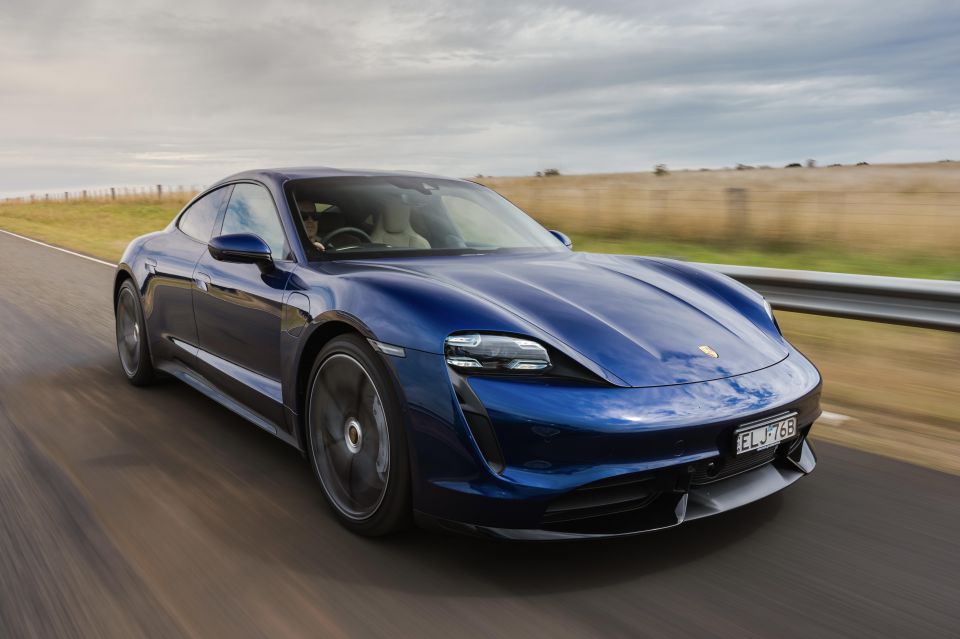

CarExpert.com.au
The CarExpert team's favourite cars of 2025
2 Days Ago
The Taycan is a proper Porsche performance car that just so happens to be electric.



Senior Contributor
New from
$190,400
excl. on-roads

Senior Contributor
New from
$190,400
excl. on-roads


Senior Contributor
New from
$190,400
excl. on-roads

Senior Contributor
New from
$190,400
excl. on-roads
Quickly see how this car stacks up against its competition. Select any benchmark to see more details.
Where expert car reviews meet expert car buying – CarExpert gives you trusted advice, personalised service and real savings on your next new car.
Expectations around Porsche’s first electric car are crushing. It’s always this way when Stuttgart’s finest launches anything new.
The Taycan is a ground-up EV made to tackle Tesla in tech terms. But it’s expected to drive like any other Porsche sports car, which is to say with the technical proficiency and emotional connection that no rival can match.
The Taycan’s story goes back to the Frankfurt motor show of September 2015, when Porsche whipped the covers from a concept car called Mission E. I was there, so the road-going version’s launch feels like the closing of a circle.
Picturedabove: Slide the white line to see the exact differences between the Mission E and Taycan
Credit to Porsche’s designers for keeping the concept’s lines (albeit losing the rear-hinged back doors). The Taycan looks menacing, with a silhouette that’s more stretched 911 than Panamera. It’s also the most aerodynamic Porsche, with a drag coefficient as low as 0.22.
There are three variants in the 2021 Porsche Taycan range: Taycan 4S, Taycan Turbo, and Taycan Turbo S. This review is based on the Australian media launch, where we had quick on-road stints in all three.

The Taycan 4S is priced at $190,400 before on-road costs, the Taycan Turbo is $268,500, and the Taycan Turbo S is $338,500.
Just to give that some context, the Porsche Panamera E-Hybrid PHEV range is priced between $245,900 and $420,800. Moreover, the cheapest way into a 911 is the $236,300 Carrera coupe. So, it’s actually reasonable.
Some pseudo competitors include the Audi RS7 ($224,000), BMW M5 Competition ($246,900), and Mercedes-AMG E63 S ($250,400). Oh, and the 2022 Tesla Model S Plaid+ range topper is $189,990.


Buy your new car without the stress. It's fast, simple and completely free.

Great service from Travis and team, second time I have used this business would not hesitate to recommend them to anyone
Craig C.
Purchased a Ford Ranger in Sunshine Coast, QLD
CarExpert helped Craig save thousands on his Ford Ranger, now let us save you on your next new car.
Find a dealTaycan 4S: $190,400
The base car has a 79kWh (gross) battery, 20-inch wheels, red brake calipers, 360mm six-piston front and 358mm four-piston rear discs, air suspension, adaptive LED headlights, rain-sensing wipers, thermally insulated glass, proximity key access, black side skirts and rear diffuser, a tyre-pressure monitor, and flush auto-deploying door handles.
Inside the 4S there’s two-zone climate control, carbon filtration, electrically-adjustable part-leather seats with heating and ventilation up front, a heated steering wheel, an electric boot lid, and a 360-degree camera.
The instruments are displayed on a monster 16.8-inch curved digital display with five view options. The infotainment touchscreen has online navigation, Apple CarPlay, digital radio, and a LTE communication module with embedded SIM. There’s also a 14-speaker Bose sound system and four USB-C points.


Taycan Turbo: $268,500
Stepping up gets you a 93kWh (gross) battery, Porsche Surface Coated Brakes with white calipers, bigger 410mm/365mm discs, Porsche Torque Vectoring Plus, electro-mechanical active anti-roll bars, different 20-inch wheels, body-coloured skirts and diffuser, and Matrix LED headlights.
Inside the Turbo are extra features including four-zone climate control, heated back seats, full-leather or optional leather-free vegan trim (the latter is $1000 more), ‘Race-Tex’ micro-fibre roof lining, ambient interior lighting, and stainless steel pedals.


Taycan Turbo S: $338,500
This range-topper adds the Sport Chrono package with driving mode dial on the steering wheel, rear-axle steering, ceramic-composite brakes (10-piston and 420mm front, four-piston and 410mm rear), and 21-inch ‘Mission E Design’ wheels, carbon exterior trims, and electrically-moving charge-point covers.
Inside there are extras including the choice of leather or vegan trims, a Porsche Electric Sport Sound cabin noise induction system, 18-way electric Adaptive Sports Seats with Turbo S logos, as well as ‘Darksilver’ and ‘Carbon Matt’ interior trims and accents.


Options:
You can fit the bigger capacity 93kWh battery to the 4S ($11,590), plus the Porsche Torque Vectoring Plus system ($3120), Matrix headlights ($3620), active anti-roll bars ($6870), leather trim ($7540), vegan trim ($8530), Race-Tex roof lining ($3970), and four-zone climate control ($1720).
The 4S and Turbo can both be optioned with the fake sound enhancer ($1050) Sport Chrono pack ($2340), rear axle steering ($4900), 21-inch Mission E Design wheels ($6770), and electric charge-point covers ($1310).
There’s also the option of a touchscreen mounted ahead of the front passenger, through which you can alter cabin settings without distracting the driver.
More: Porsche Taycan price and specs

Safety features include an active bonnet, dual front airbags, front and rear side airbags, curtain airbags covering both rows, a driver’s knee airbag, and rollover protection.
Standard active safety (not always a Porsche strong suit) includes lane-change assist (blind-spot monitor), lane-keeping aid, adaptive cruise control, autonomous emergency braking, and front/rear parking assist.
Crash tester Euro NCAP awarded the Taycan a five-star score in 2019: 85 per cent for adult occupant protection, 83 per cent for child occupant protection, 70 per cent for pedestrian/cyclist protection, and 73 per cent for safety assist.

Th days of Porsche cabins being bastions of analogue controls are waning. The Taycan’s interior has screens, screens, and more screens – the only thing with moving mechanical parts at the forefront is that clock atop the dash.
There’s a huge curved-glass instrument display behind the signature (perfect) steering wheel that’s endlessly configurable. There are even smaller inbuilt touch-sensitive points to change your damper settings in the top-right.
Below this curved glass and flanking the wheel are a starter button (right) and a strange little rocker-like switch to control gears (left). You need to hold down the starter button for a second or two to make sure the Taycan actually switches off.


The central 10.9-inch screen controls all infotainment, which is as contemporary in terms of processing power and graphics as you’d expect. As well as touch, it can also operate via conversational ‘Hey Porsche’ activated voice control.
The second touchscreen ahead of the front passenger lets them play with the navigation, audio, or phone, and leaves the driver to the driving.
Below the centre screen sits a touchpad with haptic feedback to control ventilation or infotainment shortcuts. There’a a blank section near the bottom that lets you effectively operate a hidden cursor with your fingertip.


There are copious trim choices and colours, with my two picks being either red leather or the cool leather-free suede-and-mesh trim. Regardless, every surface I touched felt satisfyingly tactile, and the build quality felt flawless.
Complaints are few and far between for front occupants, but I can think of four.
Not all versions came with a head-up display as standard-fit, nor did any come with a Qi wireless phone charger. Both are odd omissions.


The heavy reliance on screens also means that in direct sunlight, the cabin can become absolutely covered in fingertip smudges and visible dust.
Finally, a few functions that are controlled by the touchscreen really shouldn’t be. For example, you cannot physically move the air vents, and instead need to alter the direction of air flow via touchscreen controls. This is a fiddly pain in the arse to do while driving.
To the rear. At 4963mm long, the Taycan is quite a big vehicle, but if you’re after a practical family option then you should wait for the imminent Taycan Cross Turismo.


The seats are nicely scalloped and comfortable, and there’s connectivity and ventilation controls back there. But, headroom and toe room for taller adults is pretty limited, on account of the sexy low roofline.
The boot capacities are nothing special either: 366 litres in the rear and 84L up front, meaning combined they offer less stowage space than a humble Honda Civic.
It’s not really a car for golfing buddies to share, I’d venture…


Nothing. There’s a front boot where an engine would normally go. But the drivetrain complexity is next level anyway. Deep breath.
The three launch grades use proprietary 16,000rpm-capable permanent magnet motors at the front and rear axles, meaning fully variable direct all-wheel drive (AWD). The rear-drive Taycan option should arrive in 2022.
There are various states of tune, and Porsche claims all powertrain components are newly developed. Both ends also have their own pulse-controlled inverter that converts battery DC power to motor AC power (600A in the Turbo S, 300A in the others).

Where expert car reviews meet expert car buying – CarExpert gives you trusted advice, personalised service and real savings on your next new car.
Front motor power is 150kW/300Nm in the 4S, 175kW/300kW in the Turbo, and 190kW/400Nm in the Turbo S, leaping to 440Nm with launch control. All iterations use a single-speed transmission with two planetary gear seats.
The rear motor makes 335kW and 550Nm in the Turbo and Turbo S, and 270kW/340Nm for the base 4S without the uprated battery.
The rear axle powerplant also houses a separate two-speed transmission, and the electronically-actuated LSD. One gear hurls you off the line, while the second ratio overlaps and reduces the tapering of torque delivery.

The base Taycan 4S with smaller-capacity battery has a system output of 320kW/640Nm, stretching to 360kW/650Nm if you option the larger battery.
The Turbo’s outputs are 460kW/850Nm and the Turbo S has 460kW/1050Nm. The Turbo S also has an extra 60kW of overboost reserves over the Turbo.
The 0-100km/h times are respectively 4.0 seconds, 3.2sec, and 2.8sec, and the standing quarter-mile times vary between 10.7sec and 12.3sec. Top speed maxes out at 260km/h.

Furthermore according to Porsche, the Taycan performed 26 separate 0-200 km/h launch control acceleration tests in succession. Each time was under 10 seconds, and the difference between the first and last tests was less than one second.
As flagged above, the lowest-capacity battery stores 79kWh gross or 71kWh net, while the Performance Battery Plus has 93kWh gross/84kWh net. The driving range varies from 365km (4S), 420km (Turbo), and 405km (Turbo S).
The 800V electrical architecture means you can put a DC CCS charger into the passenger-side port and pull down up to 270kW of charging power, to take the car to 80 per cent charge in under 25 minutes.
An 11kW AC Type 2 wallbox will charge the battery from zero to 100 per cent in about nine hours.

| 4S | Turbo | Turbo S | |
|---|---|---|---|
| Front motor | |||
| Power | 150kW | 175kW | 190kW |
| Torque | 300Nm | 300Nm | 400Nm |
| Transmission | Single-speed | Single-speed | Single-speed |
| Rear motor | |||
| Power | 270kW | 335kW | 335kW |
| Torque | 340Nm | 550Nm | 550Nm |
| Transmission | Two-speed | Two-speed | Two-speed |
| System outputs | |||
| Power | 360kW | 460kW | 460kW |
| Overboost | 390kW | 500kW | 560kW |
| Torque with launch control | 650Nm | 850Nm | 1050Nm |
| Times | |||
| 0-100km/h | 4.0sec | 3.2sec | 2.8sec |
| 0-200km/h | 13.3sec | 10.6sec | 9.6sec |
| 0-400m (1/4 mile) | 12.3sec | 11.1sec | 10.7sec |
| V-Max | 250km/h | 260km/h | 260km/h |
| Battery | |||
| Gross capacity | 79.2kWh | 93.4kWh | 93.4kWh |
| Net capacity | 71kWh | 83.7kWh | 83.7kWh |
| Driving range | 365km | 420km | 405km |

Our test drive came at a Porsche event using public roads, so in no way did I scratch the surface of this car’s abilities. We’re working to get a Taycan or two into our garage on a longer loan as soon as possible.
First impressions are good. The driving position is reminiscent of any other low-slung Porsche sports car, putting you perfectly in control. There’s something about Porsche wheels and seating positions…
The Turbo S’s acceleration is sufficient to make your stomach seek an emergency exit, pinning you to the chair. The 4S’s acceleration is less violent, but scarcely less relentless. If only we had a track on the launch day.

Incidentally, I can’t really get into the noise inducted into the cabin. Embrace the eerie motor silence and keep a naturally-aspirated V8 weekender in the garage, I reckon.
Of course, all EVs hammer off the line. It’s actually corners, pockmarked roads, and emergency braking situations that sort the appliances from the sports cars.
The front suspension comprises an aluminium double-wishbone design and the rear uses multiple linkages. Weight distribution is 51 per cent rear.




There’s an electronic shock absorber control system synced to the driving modes, and three-chamber air suspension that can raise or lower the body by about 40mm in breadth.
There are also various stability control modes including one that controls lateral movement “like an elastic band”, body-roll-countering active anti-roll bars with 200m/s operational speeds, rear-axle torque vectoring, and rear-axle steering (same direction at high speeds, opposite in town) depending on grade.
This feels like such a cohesive package, with direct and well-weighted steering, and capable of directional changes far more rapid than a 2.3-tonne unladen vehicle weight would suggest possible. This car must be seriously stiff.




We’ve all seen the videos of Taycans drifting and doing burnouts in capable hands on circuits by now, haven’t we?
As mentioned earlier in the piece, the brakes are bloody massive. Yet about 90 per cent of stopping events are covered through recuperative resistance, sparing the brake pads. The maximum regeneration power is claimed as 265kW.
I hopped out of a Turbo S after some hard braking situations, and sheepishly touched the brakes. They were scarcely warmer than the ambient air temperature.

I also rate the ride quality very high, thanks to that air suspension.
Body control is never anything other than flat against lateral loads, yet no sporty car on such slim-sidewall tyres should isolate you from corrugations quite this well.
It’s either witchcraft or seriously good engineering.

Porsche’s warranty only covers you for three years, or eight years and 160,000km for the battery.
There’s no capped-price service plan, and intervals are up to 24 months apiece.
Porsche Australia has done a deal to give owners three-year subscription to the Chargefox public charging infrastructure. It also contracts the affiliated company JetCharge to install wall boxes at your home, office, or fancy ski lodge.

All EVs are fast off the line, and are by their very nature tech showcases for their maker. The Taycan is no exception, though Porsche sets the bar quite a bit higher.
What the Taycan brings to the table is a sense of cohesion, obsessive attention to every minute detail (I’ve never in my life waded through a longer media kit), and driving characteristics that bely the car’s weight and size.
This really is a proper Porsche that stirred my soul, even in the absence of combusting fuel.
Indeed, if you sat down and thought about what the ideal first Porsche electric car might be, you’d probably come up with something very much like the Taycan.

Click the images for the full gallery
Where expert car reviews meet expert car buying – CarExpert gives you trusted advice, personalised service and real savings on your next new car.


CarExpert.com.au
2 Days Ago


Damion Smy
4 Days Ago


Damion Smy
7 Days Ago


Max Davies
9 Days Ago


Ben Zachariah
11 Days Ago


Max Davies
12 Days Ago